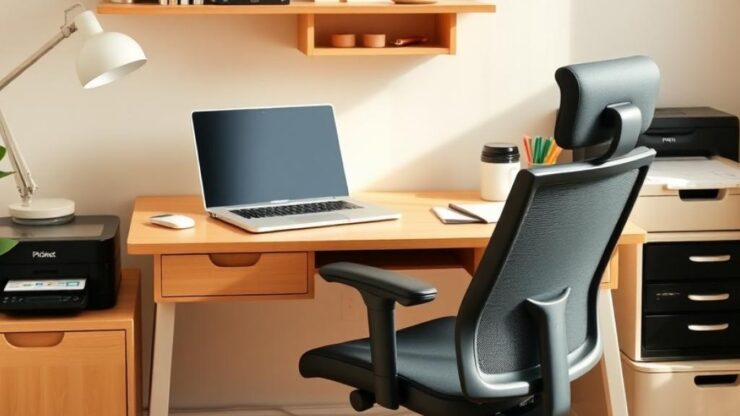Identifying Essential Home Office Expenses
In today’s remote work culture, identifying essential home office expenses is crucial for both personal and financial planning. The transition from a traditional office to a home-based workspace can introduce a variety of costs that need to be accurately tracked and managed. This article will guide you through the fundamental categories of expenses that you should consider when budgeting for your home office.
To create a comprehensive budget, it is vital to break down your expenses into manageable categories. Each category reflects a different aspect of your home office setup that contributes to your overall productivity and work environment. Below is a detailed overview of these essential categories:
- Equipment and Furniture: This includes desks, chairs, computers, printers, and other necessary hardware.
- Utilities: A portion of your electricity, internet, and heating costs can be allocated to your home office.
- Software and Subscriptions: Expenses related to productivity software, cloud storage, and communication tools.
- Office Supplies: Regular purchases such as paper, pens, and other stationery items.
- Insurance and Maintenance: Any additional insurance coverage for your office equipment and maintenance costs.
Once you have identified the essential categories of expenses, the next step is to evaluate and compare these costs. Keeping track of your expenses can help you identify areas where you might save money or need to allocate more resources. Below is a simple table to guide you through this evaluation process:
| Expense Category | Estimated Monthly Cost | Notes |
|---|---|---|
| Equipment and Furniture | $150 | One-time investment or lease options available. |
| Utilities | $100 | Proportionate share of home expenses. |
| Software and Subscriptions | $50 | Consider free alternatives. |
| Office Supplies | $30 | Regular replenishment needed. |
| Insurance and Maintenance | $20 | Check for additional coverage options. |
By diligently tracking these expenses, you will not only gain better control over your finances but also be equipped with the information needed to make informed decisions regarding your home office setup.
Creating a Comprehensive Budget Plan
Establishing a well-structured budget plan for your home office isn’t just a matter of tracking expenses; it’s about understanding the dynamics of your work environment and aligning your financial resources accordingly. A comprehensive budget can help you identify essential investments that enhance productivity and comfort while ensuring that your spending remains within reasonable limits. By carefully planning your finances, you can create a workspace that not only meets your professional needs but also promotes efficiency and well-being.
When creating your budget, start by assessing your current expenses and anticipating future costs. This involves looking beyond immediate purchases to consider long-term investments like ergonomic furniture or high-quality equipment. It’s crucial to forecast these expenses accurately, as they can significantly impact your overall budget. By doing so, you can allocate funds more effectively and avoid surprises that could disrupt your financial planning.
Once you’ve outlined your expenses, the next step is to prioritize them based on necessity and relevance to your work. It’s important to distinguish between what you need and what would be nice to have. For instance, while a high-end computer might seem like an attractive option, if your current device suffices for your daily tasks, it may be wiser to invest in other areas such as office supplies or software subscriptions. This prioritization process allows you to channel your resources towards the most impactful areas, optimizing your budget without compromising on quality.
Budgeting is not a one-time task; it requires ongoing assessment and adjustment. Regularly monitoring your expenses will provide insights into spending patterns and areas where you can cut back if necessary. Consider implementing a monthly review process to analyze your financial performance against your budget. This approach will enable you to identify trends, adjust forecasts, and make informed decisions about future expenditures. Adapting your budget as circumstances change—whether due to increased workload or shifting project demands—ensures that your home office remains a productive and cost-effective space.
Tracking and Analyzing Monthly Spending
In the realm of home office budgeting, the importance of tracking and analyzing monthly spending cannot be overstated. As remote work becomes a permanent fixture for many, the need for a systematic approach to financial oversight has emerged. By keeping a close eye on expenditures, you can not only stay within your budget but also identify opportunities for savings that can enhance your work environment.
The first step in effectively managing your home office expenses is to develop a robust tracking system. This system should facilitate the recording of every expense related to your workspace, from small office supplies to larger investments in equipment. Utilizing digital tools like budgeting apps or spreadsheets can greatly simplify this process. The key is to be diligent and consistent—update your records regularly to ensure accuracy.
Once you have established a tracking system, the next step is to analyze your spending patterns. This involves reviewing your monthly expenditures to identify trends and irregularities. Are there particular categories where you consistently overspend? Are there fluctuations in utility costs that warrant further investigation? By breaking down expenses into categories—such as equipment, supplies, and utilities—you can easily pinpoint areas that may require adjustments.
To assist you in analyzing your spending effectively, consider the following steps:
- Review Monthly Reports: At the end of each month, compile a report detailing your total expenses by category.
- Compare with Budget: Assess your actual spending against your budgeted amounts to identify discrepancies.
- Identify Trends: Look for patterns over several months to understand where adjustments may be necessary.
- Make Informed Decisions: Use your analysis to make strategic decisions about future expenditures, prioritizing essential items while cutting back on non-essentials.
By diligently tracking and analyzing your monthly spending, you create a feedback loop that informs your budgeting process. This proactive approach not only keeps your finances in check but also empowers you to cultivate a home office that enhances your productivity and satisfaction.
Strategies for Reducing Home Office Costs
In the current climate of remote work, managing home office expenses effectively is essential. Understanding how to optimize your spending can lead to significant savings while still maintaining a productive workspace. This article will delve into several strategies that can help you reduce costs without compromising on quality or efficiency.
One of the most effective ways to cut down on home office expenses is by leveraging technology. Utilizing free or low-cost software solutions can replace expensive subscriptions that add up over time. For instance, instead of investing in premium office suites, consider open-source alternatives that offer similar functionality without the hefty price tag. Additionally, using cloud-based storage can minimize costs associated with physical storage solutions, while also enhancing data accessibility and security.
Office supplies often represent a significant portion of home office expenses. To minimize these costs, it’s wise to assess your actual needs versus what you might be tempted to purchase. Opt for bulk purchasing or subscription services that offer discounts for regular orders. Additionally, consider repurposing existing items or buying second-hand equipment, which can save substantial amounts without sacrificing quality. Moreover, keeping track of your inventory can help in planning your purchases more effectively, ensuring that you are only buying what you truly need.
Your home office setup indirectly influences your utility bills, particularly for electricity and internet services. To bring down these costs, consider implementing energy-efficient practices. Simple changes, such as using LED lighting or unplugging devices when not in use, can lead to lower electricity bills. Furthermore, reevaluating your internet plan to ensure you are not overpaying for bandwidth can yield considerable savings. Bundling services or negotiating rates with your provider may also provide additional financial relief.
Leveraging Tax Deductions for Home Office Expenses
As remote work transitions from a temporary solution to a long-term arrangement for many professionals, understanding the financial implications becomes increasingly important. One of the significant benefits of maintaining a home office is the potential for tax deductions that can alleviate the financial burden associated with remote work. This section delves into how to effectively leverage tax deductions to optimize your home office budgeting.
Before you can take advantage of tax deductions, it is essential to understand the criteria for eligibility. The IRS outlines specific requirements that must be met to qualify for the home office deduction. Generally, your home office must be used regularly and exclusively for business purposes. This means that the space should not serve as a multi-functional area, such as a guest room or playroom, during work hours.
Once you have confirmed your eligibility, identifying the types of expenses that qualify for deductions is crucial. Below is a list of common home office expenses that can be deducted from your taxable income:
- Direct Expenses: Costs that are solely associated with your home office, such as office supplies, furniture, and equipment.
- Indirect Expenses: A proportional share of your home’s expenses, including utilities, rent or mortgage interest, and property taxes, relative to the size of your office space.
- Depreciation: If you own your home, you may also be able to deduct a portion of the depreciation of your home over time.
- Internet and Phone Costs: If you use your internet connection or phone for business purposes, a percentage of these expenses can also be deducted.
To maximize your deductions, accurate documentation of all relevant expenses is critical. This includes keeping receipts and records of your purchases, as well as tracking the square footage of your home office compared to your entire home. Consider using accounting software or a dedicated spreadsheet to maintain organized records of your expenses. This practice not only simplifies tax preparation but also ensures you are prepared in case of an audit.
In addition to maintaining thorough records, it’s advisable to consult with a tax professional who can provide tailored advice based on your individual situation. They can help you navigate the complexities of tax laws and ensure you are taking full advantage of the deductions available to you.
Disclaimer
This article has been created or edited with the support of artificial intelligence and is for informational purposes only. The information provided should not be considered investment advice. Please seek the support of a professional advisor before making any investment decisions.






